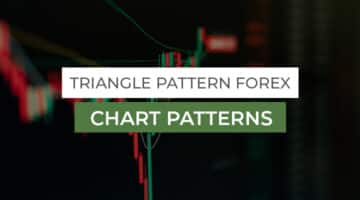Daily Indicators
In this article
In the beginning, newcomers to the Forex market may feel overwhelmed with technical analysis. However, choosing the right daily indicators to fit your trading style and strategy is essential when trading financial markets.
This article introduces some of the essential Forex technical indicators available from the main groups – trend, momentum, volatility, and volume – and shows you how they work. We will then present a day trading strategy based on three technical indicators.
What are technical indicators?
A technical indicator is a mathematical tool that analyses one of the following five figures: open price, high, low, closing price, and volume. Using the calculation, we can plot technical indicators in the form of chart patterns. In some cases, they are overlaid on the price chart, and in others, they are drawn separately. For example, many technical indicators exist for Forex.
Anyone with coding skills can create their own, but keep in mind that you will only benefit from a certain amount of information. In addition, it is essential to remember that the majority of technical indicators were developed well before the internet. They were designed for stock and commodities markets and high timeframes since trading charts were updated every 24 hours.
The best Forex indicators
Below are some of the best and most popular Forex indicators available to traders of all types, and they are already part of most charting packages. Let’s examine them one by one in more detail so you can see what they do and how you might use them to build a trading strategy that uses indicators:
1. Moving averages
A moving average is an indicator in technical analysis that represents the market’s closing price over a specified time interval. Traders often use moving averages because they can give a good indication of the current market momentum.
Market fluctuations are minimised with the help of the moving average. In addition, traders can use moving averages to identify the market’s overall trend simply since moving averages are average closing prices over a specified period.
Traders can also choose the suitable timeframe for their trading objectives by using the moving average as a customisable indicator. Market entries are often determined by moving averages and support and resistance levels. A moving average can serve as a support or resistance level, depending on the price above or below the MA.
2. Relative Strength Index
According to the relative strength index (RSI), temporary overbought or oversold scenarios in a market are typically indicated. Therefore, using the RSI indicator, you can devise an intraday trading strategy to profit from indications that a market may be overextended and likely to retrace.
In technical analysis, the RSI is an oscillator and a widely used indicator that indicates an overbought market when the RSI value exceeds 70 and an oversold market when the RSI value falls under 30.
Some traders and analysts prefer to use more extreme readings of 80 and 20.1. One drawback of the RSI is that it is susceptible to spikes repeatedly up and down, which may generate false signals. When used with other signals, the spikes or falls could indicate an entry or exit point.
It is not uncommon for the RSI to indicate that the market is either overbought or oversold well after the price has extended past that point. As a result, RSI trading strategies work best with other technical indicators to avoid entering trades too early.
3. MACD
An indicator called Moving Average Convergence Divergence (MACD) is simply a measurement of the relationship between exponential moving averages (EMAs). There is a MACD line (blue), a signal line (red), and a histogram (green) on the MACD showing how the MACD line differs from the signal line.
MACD lines are calculated by subtracting two exponentially smoothed moving averages, usually 12 and 26, and signal lines are usually 9-period exponential smoothed averages of the MACD lines.
There are peaks and valleys between these MACD lines. Consequently, the MACD exhibits characteristics of an oscillator, giving signals of overbought and oversold conditions above and below the zero line.
Due to its dual function, the MACD is a MACD crossover indicator and an oscillator. A chart with this dual-purpose indicator will be less cluttered as it provides two signals in one. Therefore, understanding this indicator may be beneficial to traders.
4. Bollinger Bands
Technical analysis, or Bollinger Bands, allows traders to plot trend lines two standard deviations away from a security’s simple moving average price. The objective is to help traders identify when assets have been overbought or oversold to enter or exit a position accordingly. John Bollinger invented Bollinger Bands.
Bollinger Bands make it easier to identify changes in volatility. Bollinger Bands can buy and sell securities with relatively steady ranges, such as many currency pairs. When placing trades based on Bollinger Bands, traders look at factors other than stop-outs and frustrations.
Bollinger Bands can provide insight into when to enter and exit a position by assessing the market’s volatility when used by traders. A Bollinger Bands technique, such as the Squeeze, works well for Forex traders, adding a second band. Investors and traders can use this tool effectively to make better decisions and hopefully earn profits.
5. Stochastic
A prevalent tool for technical analysis, stochastic oscillators are available on most trading platforms, and traders worldwide use them. According to George Lane, a renowned technical analyst, prices tend to close near the candlestick’s upper end during price movements upward and near the candlestick’s lower end during price movements downward. Similarly, the stochastic shows where the price closed over a specified period compared to a specific range.
A trend moves upward when prices cluster near the top of a specific range, whereas a trend moves downward when prices cluster near the bottom. %K and %D are the two lines of the Scholastic Oscillator. It is %D that generates the significant signals.
Indicators such as stochastics can determine when a specific period is overbought or oversold. Traders prefer stochastic oscillators when the price fluctuates because the price signals the stochastic oscillator more reliably when the price fluctuates. However, traders should not simply enter the short position at overbought levels in up-trending markets; or go long in down-trending markets based on oversold conditions as reflected by the indicator.
6. Ichimoku Kinko Hyo
Ichimoku Kinko Hyo or Ichimoku Cloud creates a complete trading strategy among the Forex indicators. This indicator helps traders detect all aspects of the market through several elements.
As the first variable of this indicator, Kumo Clouds help to understand the market context. Prices trading below the Kumo Cloud signify a bearish trend, while prices above the Kumo Cloud signify a bullish trend.
It plots more information than your typical technical analysis tool, so Ichimoku is considered one of the most advanced indicators. Practice helps you become adept at absorbing data at a glance. Its graphical summary of price action should help you make better trading decisions as time passes.
You can practice without risking any money on a demo account, which is the best way to improve your skills.
7. Fibonacci
As Fibonacci is related to every living thing in the universe, it is one of the most accurate trading tools on the market. Fibonacci’s golden ratio of 1.618 is its most significant element. A trader uses this ratio to identify a market reversal or profit-taking area in the Forex market.
If the price moves in a trend, corrects to the 61.8% Fibonacci retracement level and then reverses direction, the price will likely move to the 161.8% Fibonacci extension level.
Furthermore, other Fibonacci levels can be calculated based on the market behaviour and momenta, such as 23.6%, 38.2%, 50.0%, 88.6%, 127.0%, and 261.8%.
8. Average True Range
ATR is a volatility indicator that reveals how much a particular asset moves, on average, throughout a given period. By using this indicator, day traders can confirm when they should initiate a trade and where they should place a stop-loss order.
As a volatility indicator, the actual average range (ATR) provides how much you should expect the price to move. Traders can use this indicator with other strategies and indicators to plan trade entry and exit points.
An ATR indicator works best with several 14, but that isn’t the only strategy that works. Lower numbers are also effective in emphasising recent volatility. However, long-term investors may prefer a more significant number to have a broader perspective.
9. Parabolic SAR
J Welles Wilder developed the Parabolic SAR, a technical indicator that can identify the direction of an asset. Stop and reverse systems, also known as SARs, are also included in this indicator. The objective of the model is to detect potential reversals in asset prices. However, it can also identify potential entry and exit points for traders.
SARs work primarily in trending markets. Wilder advises traders to use the parabolic SAR to determine the direction of the trend before using alternative indicators to determine its strength.
When plotted directly on a chart, the Parabolic SAR indicator appears as a series of dots. In the case of a parabolic SAR below the current price, it indicates a bullish trend. Conversely, this is regarded as a bearish signal if it is above the current price. Profit targets and stop losses are based on the signals.
10. Pivot Point
The pivot point indicates potential turning points developed by floor traders in the commodities market. For example, day traders use pivot points in the Forex market and other markets to evaluate likely levels of support and resistance, which can indicate when a trend will turn bullish or bearish.
Traders still need a viable system to consistently win using pivot points, no matter how valid the point is at predicting turning points. There are entry points, stop-loss triggering mechanisms, and profit targets or signals for the exit with all trading systems.
Day traders can figure out where most other traders will enter, stop, and take profits using pivot points. You can find free Forex pivot point calculators on retail Forex brokers’ websites and third-party sites.
A successful trading method uses pivot points in conjunction with other technical indicators, such as trend lines, Fibonacci levels, moving averages, previous highs and lows, and last month’s closing price.
Why are FX indicators useful?
Beginners often think more is better for indicators, but more indicators do not necessarily mean better information or better trading decisions. Some technical indicators provide no additional information; they are just duplicates or alternatives.
A chart with too many data points can make the information confusing and hard to understand. Whenever you decide to execute a market order, hesitancy can arise, and these efforts will prove counterproductive. As tools, technical indicators can produce inaccurate results in the wrong hands.
Using the technical indicators you have placed on your charts, your mission is to interpret their signals to determine whether to enter the market, change your stop-loss, take partial profits, or close a trade.
FAQs
- What are some excellent Forex indicators?
Forex indicators like the stochastic oscillator, moving averages, and relative strength index is the best.
- How do you read the relative strength index?
The relative strength index is based on a 0 to 100 scale. If it falls below 30, overspending has likely occurred. A reading higher than 70 indicates selling might be a good idea.
- What are the flaws of stock market indicators?
You can use indicators to assess averages and momentum quickly, but they’re not perfect market predictors, even if they’re referred to as “leading” indicators. Instead, analysing indicator readings with historical levels can hint at possible outcomes. Nevertheless, none of these uses is inevitable, and something unprecedented can always occur that negates previous success.
Bottom line
Most traders should know how to use Forex indicators. However, it is important to remember that the effectiveness of technical trading indicators depends on how they are used. Traders use different indicators for different parameters to boost their chance of predicting market movements.
Inexperienced Forex traders often mistake using too many indicators and relying only on the values they see to enter and exit trades. A trader who relies too heavily on indicators can overtrade, lose big money, and lose all confidence, as they never learn to read the market independently.
Jason Morgan is an experienced forex analyst and writer with a deep understanding of the financial markets. With over 13+ years of industry experience, he has honed his skills in analyzing and forecasting currency movements, providing valuable insights to traders and investors.
Forex Content Writer | Market Analyst
Relevant Posts
Divergence in Forex Trading
[top_three_brokers] The Forex divergence occurs when a currency pair's price moves in one direction, but the trend…
Read more

What is the Benefit of a Forex Calculator?
[top_three_brokers] You should always carry a forex position calculator if you are a trader. It…
Read more
Forex Traders in South Africa
[top_three_brokers] The forex market is intrinsically risky, but it has also allowed many people to…
Read more

What is a Forex Broker?
[top_three_brokers] Do you want to know the concept of what a forex broker is? For…
Read more

Triangle Pattern Forex – Chart Patterns
[top_three_brokers] Learning how to trade triangle patterns in forex correctly is paramount if you are…
Read more

FP Markets Minimum Deposit
[top_three_brokers] [single_affiliate title="" id="4271" size="big"] This guide will cover the FP Markets minimum deposit and…
Read more

Forex Trading Patterns
[top_three_brokers] In a forex market, forex trading patterns are the ultimate trails that lead investors to perform…
Read more

FXCM Demo Account
[top_three_brokers] [single_affiliate title="" id="5200" size="big"] To understand what FXCM is all about and how you…
Read more

AvaTrade Bonus Promotion
[top_three_brokers] [single_affiliate title="" id="412" size="big"] AvaTrade is currently offering welcome deposit bonuses and referral bonuses.…
Read more

Best MetaTrader Indicators
[top_three_brokers] Did you know that there are more than 2000 custom indicators available for MetaTrader…
Read more
Divergence in Forex Trading
[top_three_brokers] The Forex divergence occurs when a currency pair's price moves in one direction, but the trend…

What is the Benefit of a Forex Calculator?
[top_three_brokers] You should always carry a forex position calculator if you are a trader. It…
Forex Traders in South Africa
[top_three_brokers] The forex market is intrinsically risky, but it has also allowed many people to…

What is a Forex Broker?
[top_three_brokers] Do you want to know the concept of what a forex broker is? For…

Triangle Pattern Forex – Chart Patterns
[top_three_brokers] Learning how to trade triangle patterns in forex correctly is paramount if you are…

FP Markets Minimum Deposit
[top_three_brokers] [single_affiliate title="" id="4271" size="big"] This guide will cover the FP Markets minimum deposit and…

Forex Trading Patterns
[top_three_brokers] In a forex market, forex trading patterns are the ultimate trails that lead investors to perform…

FXCM Demo Account
[top_three_brokers] [single_affiliate title="" id="5200" size="big"] To understand what FXCM is all about and how you…

AvaTrade Bonus Promotion
[top_three_brokers] [single_affiliate title="" id="412" size="big"] AvaTrade is currently offering welcome deposit bonuses and referral bonuses.…

Best MetaTrader Indicators
[top_three_brokers] Did you know that there are more than 2000 custom indicators available for MetaTrader…



